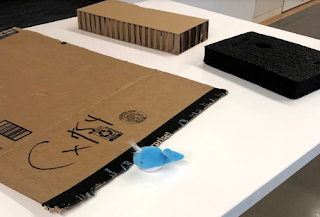I collaborated with the technology education teacher to develop a program that incorporated the work we were doing with literacy in the preschool program and adding the element of coding robots. We started the conversation by talking and sharing the different codable robots that she had in the technology department and ones that I had in the library. This was a way of “publicizing to learners, staff, and community available services and resources” (AASL 2018, School Library III.C.3). We also talked about the connection with sequencing in coding and sequencing in storytelling. We designed a series of lessons that would combine storytelling and literacy with coding and robots.
Lesson 1: Ozobots
The first step was sharing the book Bot+Boy by Ame Dyckman. This is a great book to share with young children as they are beginning to talk about robots. In the story a young boy is playing with a robot he found. They are having a wonderful time when the power switch for the robot is accidentally switched to off. The boy thinks the robot is sick so he takes him home and tries to feed him soup and put the robot to bed. During the night, the robot’s switch is clicked back to the on position. The robot seeing the boy asleep in bed thinks that the boy needs to be repaired so the robot gives him more oil and tries to plug the boy in to get more power. The books is sweet and the illustrations are wonderful. The story also includes the starting point to talk about what is different about the boy and robot. Learners shared their connections with the story and the difference between machines and people. This was a way for learners to “[Develop] new understandings through engagement in a learning group” (Learner III.A.2). We then talked about different machines that we have in our lives. Students named the different machines that they encounter in their daily lives.
Then, I introduced the first robot that the students would be exploring Ozobots. Ozobots are small robots that have a camera on the bottom of the robot. Users can draw different lines and patterns using markers and the Ozobot will read the lines and follow the path. We talked about how this was a different robot then in the story or ones that students encounter in their lives. We also talked about how you need to program or tell some robots what to do, and the way that you program an Ozobot is by drawing different lines. Then we set students up with markers, paper and Ozobots to begin to explore coding these robots!
Lesson 2: Rotating groups with Dash, Root, Mouse and Cubetto Robots
The next step was introducing students to more robots that incorporate different coding applications. We broke the students up into small groups and paired them with a different robot, a teacher and a book. We used the books by Jan Thomas. I love to use these books because the stories are fun and engaging as well as having a clear and simple, beginning, middle, and end. I make photocopies of important events from the story. The students listen to the book, then they put the images from the book in order from beginning to end. This is a collaborative process, students talk to their classmates and agree on the correct order.
The final step is showing the students how the different robots work and then they code the robot to go to each of the photocopies of the illustrations from the book from beginning to end. This is a way of highlights the sequence of a story and making connections to the sequence of coding a robot. This a process and groups need to code and recode their robots to ensure that they follow the whole path of the story. Sometimes they do not give the robot enough commands to go forward to reach different pictures or they turn the robot in the wrong direction. Then the group needs to discuss what went wrong and how they are going to fix the code to complete the challenge. In this process learners are “actively contributing to group discussions” (Learner III.D.1).
The Dash and Root robots use drag and drop coding on an ipad app to connect to the robot. Cubetto robot using different colored tiles on a board to instruct the robot to move and the Mouse robot has directional buttons on the robot that code the robot to move. We do this project over several weeks so all the students have a chance to read different stories and gain experience with different robots and different types of coding.
We do this project in the fall to introduce students to the coding robots. In the spring we do some more connected building and making projects with the robots and storytelling. This set of lessons builds a great foundation for coding that we advance as the students more through the grades.
This is not only a collaborative project for learners it is also an example of collaboration between the school librarian and a fellow educator. The tech ed teacher and I recognized shared goals with this project and found an opportunity to “[partner] with other educators to scaffold learning and organize learner groups to broaden and deepen understanding” (School Library III.A.1).


















